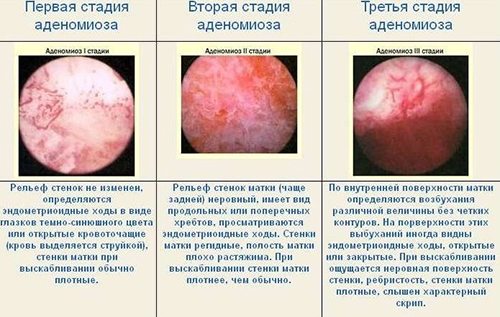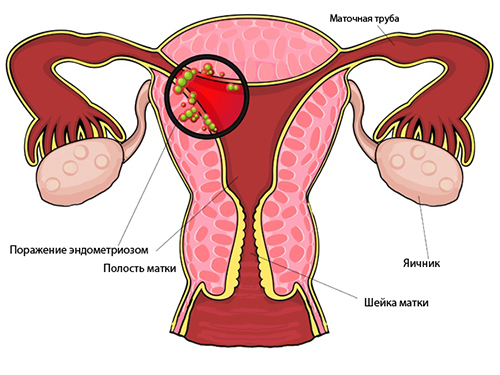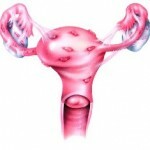Endometrium is normally located only on the inner surface of the uterus. All kinds of malfunctions in the reproductive system can lead to the localization of its cells outside the usual space. This is already a disease of adenomyosis and endometriosis, in what the difference and similarity between which can understand not only the physicians.
Features of adenomyosis
 Most diseases of the reproductive system is hormonal in nature. Not an exception and adenomyosis. Under the influence of an incorrect ratio of estrogens and gestagens, the tissues of the mucous membrane of the uterus seep into the deep layers of the organ.
Most diseases of the reproductive system is hormonal in nature. Not an exception and adenomyosis. Under the influence of an incorrect ratio of estrogens and gestagens, the tissues of the mucous membrane of the uterus seep into the deep layers of the organ.
The level of their development depends on the degree of their penetration:
- 1st stage - achievement of myometrium;
- 2nd stage - proliferation of the endometrium to the middle of the muscular layer of the uterus;
- 3rd stage - the spread of mucosal tissues to the serous cover;
- 4th stage - the appearance of endometrial cells in the parenteral peritoneum.
There are several forms of adenomyosis, too. It can affect the entire surface of the uterus( diffuse), cause the formation of fluid-filled formations( nodular) or settle in some areas( focal).

The presence of a problem a woman may notice on these grounds:
- Severe pain with menstruation. Pathologically spread tissues have the same properties as healthy ones, so they make the uterus stronger and shrink more often. The presence of foreign inclusions in its layers leads to inflammation, which always signals pain.
- Violations of the periods of the monthly. Hormonal disorder accompanying the disease, prevents the correct development of the mucosa. Hence the delay of menstruation and spotting between them.
- Ample monthly. The quantitative increase in tissues, rejected at critical days, leads to intensive secretions.

Stages of adenomyosis in a woman
With the development of the disease, beginning with the 2 nd stage, the uterus increases in size so that it is compared with the value during pregnancy. This makes it possible to suspect the presence of the disease by ultrasound. And since the uterus is the only organ that suffers from adenomyosis, hysteroscopic research will also be informative. This is its difference from endometriosis, which requires more complex diagnosis.
Endometriosis: the disease characterized by
The area of mucosal tissue distribution is the difference between endometriosis and adenomyosis. They are found outside the body of the uterus, reaching the fallopian tubes, ovaries, and vagina.
In extragenital endometriosis, mucosal tissues germinate outside the reproductive organs. The bladder located nearby, various departments of an intestine suffer more often. But there are cases when cells similar to those forming the endometrium have become entrenched and developed in other organs.

Endometriosis of the mucous membranes
Symptoms of endometriosis are sometimes mild. But if present, they are similar to manifestations occurring in the case of germination of the mucous membrane deep into the organ. There are additional signs:
- Prolonged, painful and profuse periods. Painful sensations are spread not only in the area of the uterus, but also in those where pathological tissues have developed.
- Irregular cycle, intermenstrual bleeding. This is promoted by hormonal disorder.
- Disturbances in the work of organs affected by the disease. If it is the intestine, there may be problems with defecation, hemorrhaging from the anus. With the germination of foreign tissues in the bladder, its functions are difficult. And also there is blood from the urethra.
 We recommend reading an article on endometriosis during menopause. From it you will learn about the development of the disease at this age, the methods of getting rid of climacteric endometriosis.
We recommend reading an article on endometriosis during menopause. From it you will learn about the development of the disease at this age, the methods of getting rid of climacteric endometriosis.
Reasons for confusing diseases
Many believe that endometriosis and adenomyosis are one and the same. In a sense, such an opinion is fair. After all, adenomyosis is one of the manifestations of endometriosis. Sometimes the cells of the uterine mucosa affect first its deeper layers, and then other parts of the reproductive system.
Both pathologies have a common nature of occurrence - hormonal disorder. And the factors that provoke the disease are the same:
- infections that affect the sexual and urinary systems;
- intrauterine intervention;
- hereditary predisposition.

But the difference in the location of pathological tissues dictates differences in the methods of treatment:
- From adenomyosis, first of all gets rid of the hormonal background correction. Additionally, anti-inflammatory and anesthetics, immunomodulators and vitamins are taken. Surgical treatment of adenomyosis is the last chance to get rid of it. After all, to clean with a scalpel or even a laser pathological tissue from the muscle and other layers of the uterus is unrealistic. Therefore, it is necessary to delete it.
- Endometriosis also forces the use of hormones. But surgical treatment using laparoscopy, combined with conservative therapy, does not require removal of the affected organs.
Both diseases have another common feature: to begin treatment better at an early stage. And for this you need to control your own health during critical days, monitor the characteristics of the monthly and, if necessary, immediately consult a doctor.
